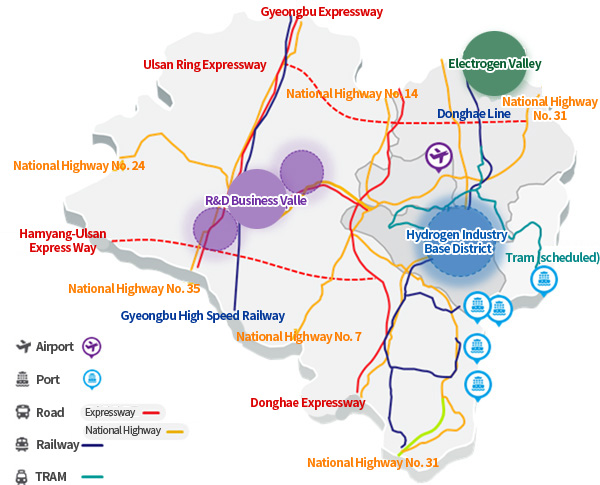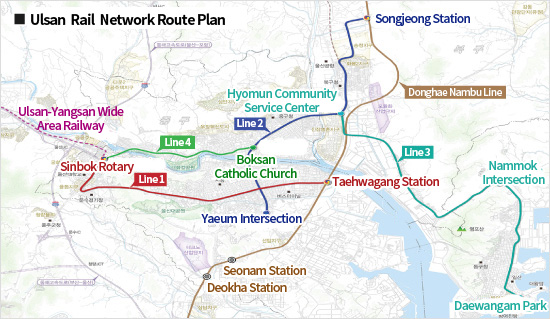Road Sector
- Total number of routes on major roads in Ulsan: 7,008
- (3 expressways, 5 general national roads, 1 national support local road and 481 metropolitan city roads, etc.)
- Total road extension: 3,374㎞
- Major expressways and national highways in Ulsan
- East-West Axis: Opening Ulsan Expressway and National Highway No. 24
- North-South Axis: Establishing Gyeongbu Expressway, Donghae Expressway, National Highway No. 7, National Highway No. 14, National Highway No. 31 and National Highway No. 35
- Hamyang-Ulsan Expressway is under construction. Ulsan Ring Expressway is scheduled to be constructed.
Classification, Main Road
| Classification |
Main Road |
| Expressway |
East-West axis |
Ulsan Expressway, Hamyang-Ulsan Express Way No. 1 and Ulsan Ring Expressway No. 2 |
| North-South Axis |
Gyeongbu Expressway and Donghae Expressway |
| National Highway |
East-West axis |
National Highway No. 24 |
| North-South Axis |
National Highway No. 7, National Highway No. 14, National Highway No. 31 and National Highway No. 35 |
Note 1) Hamyang-Ulsan Expressway is currently under construction and is scheduled to open in 2020.
2) The construction of Ulsan Ring Expressway is scheduled to be completed in 2029 as a preliminary feasibility study exemption project among the 2019 Balance National Development Project.
- Looking at the accessibility of highways by business district in the Ulsan Free Economic Zone, all business districts are located within about 20 minutes from the main entrances and exits of the highways.
Classification, Expressway, Major Entry and Exit Route, Required Time
| Classification |
Expressway |
Major Entry and Exit Route |
Required Time |
| Hydrogen Industry Base District |
Donghae Expressway |
Cheongnyang IC |
Within 5 minutes |
| Electrogen Valley |
Ulsan Ring Expressway |
Gadae IC |
Within 15 minutes |
| R&D Business Valley |
Gyeongbu Expressway |
Seo-Ulsan IC |
Within 10 minutes |
Note 1) The time required to access each expressway is calculated based on cars.
2) The construction of Ulsan Ring Expressway is scheduled to be completed in 2029 as a preliminary feasibility study exemption project among the 2019 Balance National Development Project.
- Currently, vehicles are expected to access each district in the Ulsan Free Economic Zone within 1 hour when using the roads.
- It is expected that the required time will be further shortened by 2025 when the road construction project promoted by Ulsan is completed in the future.

Project, Period
| Project |
Period |
| National Highway No. 7 (Cheongyang-Okdong): Opening of the disconnected section |
2017-2023 |
| Construction to improve busy road between Sanggae and Maeam |
2013~2021 |
| New Establishment of 4-lane on the bypass between Eonyang and Beomseo |
Proposed to the Ministry of Land, Transport and Maritime Affairs |
| Construction of Hamyang-Ulsan Expressway |
2014~2024 |
| Construction of access road to a general industrial complex in Ulsan High Tech Valley |
2016-2019 (completed) |
| Construction of Gacheon Small and Medium Business Complex Access Road |
2016-2019 (completed) |
| Construction of Gacheon Small and Medium Business Complex Access Road |
2003~2020 |
| Road Expansion Construction (Dae 1-24) between Eonyang Policy Substation and Seobu-ri |
2017~2021 |
| Infrastructure maintenance project around Ulsan Station Complex Transfer Center |
2017~2022 |
| Road construction work in the whole area of 155-5, West Eonyang (Jung No. 2-206) |
2015~2020 |
| Road construction between Bansong, Eonyang and Sangjak, Samdong |
2017~2021 |
| Construction of Ulsan Ring Expressway |
2015~2029 |
| New establishment of 4-lane between Cheongok and Oedong, Gyeongju (former Nongseo-Oedong) |
2019~2026 |
| Expansion construction of Industrial Road between Sindapgyo Bridge and Siege, Gyeongju) |
2014~2021 |
| Road construction between Okdong and Nogso 1 |
2019~2021 |
| Extension work of National Highway No. 7 (Ungsang-Mugeo) |
2012~2020 |
| Construction of the disconnected section of National Highway No. 7 (Cheongyang-Okdong) |
2017~2023 |
Railway Sector
- Gyeongbu Express Line (Seoul-Busan) and Donghae (Busan-Pohang) have been established, which are rail networks in Ulsan.
- As branch lines of the Donghae Line, there are Onsan Line, Jangsaengpo Line, and Ulsan Port Line, which connect ports and industrial complexes as transportation and logistics hubs in the region.
- Based on Ulsan Station, development projects such as exhibition and convention center and complex transfer center are in progress.
- The double track railway project of Donghae Line is in progress and it is scheduled to open in 2020.
- It is planned to connect the business districts of the Ulsan Free Economic Zone to each other through the Gyeongbu High Speed Railway and Donghae Line among the railway networks.
- Looking at the accessibility of highway stations by business district in the Ulsan Free Economic Zone, all business districts are located within about 15 minutes from the major railway stations.
Classification, Railway Line, Railway Station, Required Time
| Classification |
Railway Line |
Railway Station |
Required Time |
| Hydrogen Industry Base District |
Donghae Line |
Deokha Station |
Within 5 minutes |
| Electrogen Valley |
Donghae Line |
Songjeong Station |
Within 5 minutes |
| R&D Business Valley |
Gyeongbu High Speed Railway |
Ulsan Station |
Within 5 minutes |
Note: The time required to access each station is calculated based on cars.
- It is planned to establish 4 tram lines in accordance with the Ulsan urban rail network construction plan.
Classification, Line 1, Line 2, Line 3, Line 4
| Classification |
Line 1 |
Line 2 |
Line 3 |
Line 4 |
| Section |
Taehwagang Station-Sinbok Rotary |
Songjeong Station-Yaeum Intersection |
Hyomun Community Service Center- Daewangam Park |
Sinbok Rotary-Boksan Catholic Church |
| Extension |
11.63㎞ |
13.69㎞ |
16.99㎞ |
5.94㎞ |
| Number of Stations |
11stations |
14stations |
15stations |
8stations |
| Project Stage |
Step 1 |
Step 2 |
| Characteristic |
East-West Axis Route
The Connection of Ulsan-Yangsan Wide Area Railway |
North-South Axis Route |
Linkage axis between Dong-gu and Buk-gu |
Circular Route |
Airport Sector
- Ulsan Airport is located in Songjeong-dong, Buk-gu, and is the main airport for domestic flights that mainly handles passenger transportation.
- This airport operates regular routes between Ulsan and Seoul/Gimpo and Ulsan and Jeju (60 thousand flights per year).
- Looking at the accessibility of the airport by business district in the Ulsan Free Economic Zone, all business districts are located within about one hour from the airport.
Classification, Airport, Required Time
| Classification |
Airport |
Required Time |
| Hydrogen Industry Base District |
Ulsan Airport |
Within 35 minutes |
| Electrogen Auto Valley |
Ulsan Airport |
Within 20 minutes |
| R&DBusiness Valley |
Ulsan Airport |
Within 35 minutes |
Note: The time required to access the airport is calculated based on cars.
Port Sector
- Ulsan Port is a trading port and is divided into Ulsan Main Port, Onsan Port, Mipo Port, and Ulsan New Port, with a quay length of 20,668 meters, the berth number of 115 vessels, and a loading capacity of 71,728 thousand tons.
- Functions by Port
- Ulsan Port: Support for the handling of import and export cargo of back shippers
- Onsan Port: Support for Industrial complexes and local shippers (raw materials such as liquids and ores)
- Mipo Port: Support for the shipbuilding industry (equipment and steel)
- Ulsan New Port: Support for oil hub bases and industrial complexes (steel, raw materials and containers)
- Ulsan New Port is promoting the Northeast Asian Oil Hub Construction Project to build a commercial tank terminal with a total of 24.13 million barrels and construct a port hinterland.
Power Sector
- The total power demand of the entire project district of the ufezEng is measured as 220,812.3kW, with a total of 42,972kW for industrial facilities and 168,740.3kW for residential and public facilities and others.
Project District, Industrial Facility, Residential and Public Facility and Others, Total
| Project District |
Industrial Facility |
Residential and Public Facility and Others |
Total |
| Electrogen Auto Valley |
6,463 |
27.1 |
6,490.1 |
| Hydrogen Industry Base District |
17,193 |
36,709 |
53,902 |
| R&DBusiness Valley |
R&D District |
28,416 |
272.2 |
28,688.2 |
| Business District |
- |
131,732 |
131,732 |
| Sum Total |
52,072 |
168,740.3 |
220,812.3 |


